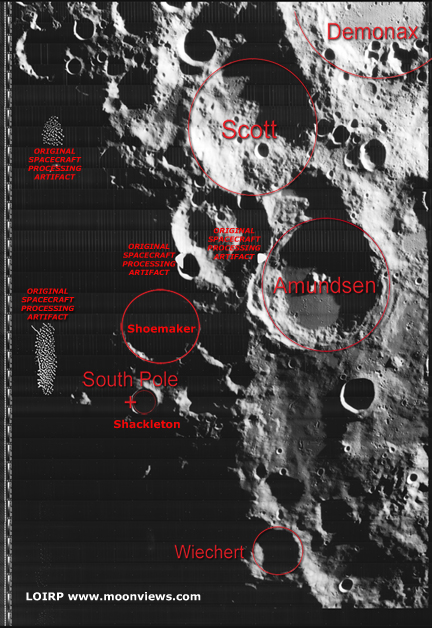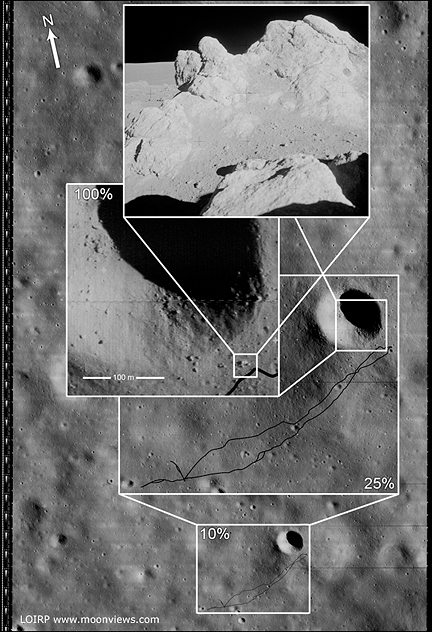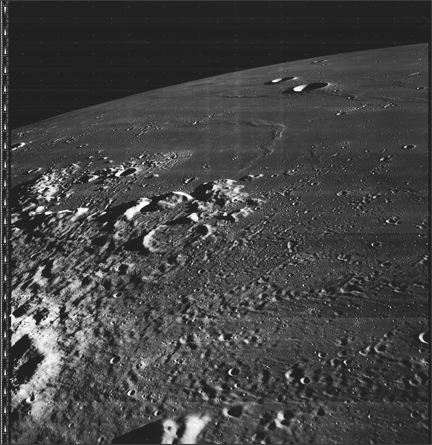
This image (LO_V-5030) of Earth was taken on 8 August 1967 at 09:05:11 GMT by the Lunar Orbiter V spacecraft in orbit around the Moon at an altitude of 5,872.85 km. This image has been described as being the first image ever taken of a “full Earth” from space. [Larger image]
Lunar Orbiter V was launched on 1 August 1967 arrived in a nearly polar orbit on 5 August at 12:48 p.m. EDT. Images were taken between 6-19 August and were sent back to Earth on 27 August 1967.
This is the orientation of Earth as Lunar Orbiter V snaped its photo from Lunar Orbit

It is easy to make out a number of geographic features in this image. [Larger image]

In addition, you can see that the detail of the clouds – especially over the Indian Ocean is much greater in this image. Further processing of this image should yield even greater detail. [Larger image]

This is one of only three images of the Earth taken from the five lunar orbiter spacecraft. In its full resolution form, you can easily see Sicily, Cyprus, the Caspian Sea, lake Bakial, and other features such as the Nile delta. The Chinese coast is visible on the upper right as well as India and Ceylon in the center of the image. In the lower right the Indonesian islands are also visible. The estimated resolution of the image on the Earth is approximately 5 kilometers.
This is the 2 inch tape reel on which this image was stored. Note on the label [much larger image] that “L.O.E.” refers to “Lunar Orbiter E” aka “Lunar Orbiter V”. The tape was recorded on day 238 of 1967 local time i.e. 26 August 1967. Starting at 06:34:38 GMT and ending at 07:26:10 GMT

This image was not in the original mission plan. According to Destination Moon: A History of the Lunar Orbiter Program (NASA TM X-3487):
“Photography commenced at 7:22 p.m. EDT on August 6. At this time the spacecraft took its first photograph of the Moon at a distance of about 6,000 kilometers from the lunar surface. The target was a previously unknown area of the far side. Then it executed a maneuver early on August 7 [294] that lowered the perilune to 100 kilometers while maintaining a 6,023-kilometer apolune. The spacecraft continued farside photography, exposing eighteen out of nineteen frames during the first part of the mission. The nineteenth was a “film set” frame, moved through the photo subsystem in an eight hour interval to prevent film from setting and Bimat from drying out. While this was a planned item In the film’s budget, the decision which program officials made early on August 7 changed the next scheduled “film set” frame significantly. They decided to use it to take a photograph of the Earth with the 610 mm high-resolution camera lens instead of passing It unexposed through the system.
Site VA-9, as the Earth photograph was identified, had not been in the original plan. Program officials decided, however, that the position of Lunar Orbiter V relative to the Moon and the Earth and the Earth’s position relative to the Sun afforded a very fine opportunity to take such a picture. The Langley program planning staff together with flight controllers implemented a plan to make an Earth photograph when the spacecraft neared apolune between orbits 7 and 8. Since the spacecraft’s orbit geometry kept it in view of Earth at all times, the Moon would not appear in [295] the photograph.
Exactly seven hours twenty-three minutes elapsed between the exposure of the previous photograph of Site VA-8 and the moment when Lunar Orbiter V’s camera made the historic picture of the nearly full Earth on August 8 at about 9:05 Greenwich Mean Time. Shutter speed was 1/100 second, but the Earth’s high albedo caused some overexposure of the film. This was unavoidable. Later Langley Research Center photography specialists successfully applied image enhancement techniques, using magnetic tape video records of the readout of the photograph, to bring out details which would not have shown up in a negative reconstructed from the raw readout data. (Note that enhancement techniques did not involve any “doctoring” of photographic data in order to “show” something which was not there.)
Approximately 149° of arc of the Earth’s surface appeared clearly in the photograph. It illustrated the possible synoptic weather observations that a satellite could conduct in cislunar space or that could be made from the Moon.”
This image has been recovered in its original high resolution format by LOIRP staff from original Lunar Orbiter project data tapes using restored tape drive hardware and will eventually be submitted to the PDS (Planetary Data System).
A full resolution version of this image is now online at the NASA Lunar Science Institute here (1.07 GB TIFF)
The first image recovered by LOIRP was the iconic “Earthrise” image taken by Lunar Orbiter a year prior to this Lunar Orbiter V image.
The Lunar Orbiter Image Recovery Project (LOIRP) is located at the NASA Ames Research Center in Moffett Field, CA. Funding and support for this project has been provided by NASA Exploration Systems Mission Directorate, NASA Innovative Partnerships Program, NASA Lunar Science Institute, NASA Ames Research Center, Odyssey Moon LLC, SkyCorp Inc., and SpaceRef Interactive Inc.
For more information on the Lunar Orbiter Image Recovery Project (LOIRP) visit https://moonviews.wpenginepowered.com
For information on NASA’s Lunar Science Institute visit http://lunarscience.arc.nasa.gov/
For information on NASA’s Exploration Systems Mission Directorate visit http://www.nasa.gov/exploration/


















 The Lunar Orbiter Image Recovery Project (LOIRP) has released another iconic image taken during the Lunar Orbiter program in the 1960’s. This image, which shows the dramatic landscape within the crater Copernicus was often referred to as the “picture of the century” by many people at the time of its original public release in 1966.
The Lunar Orbiter Image Recovery Project (LOIRP) has released another iconic image taken during the Lunar Orbiter program in the 1960’s. This image, which shows the dramatic landscape within the crater Copernicus was often referred to as the “picture of the century” by many people at the time of its original public release in 1966.
